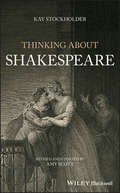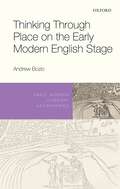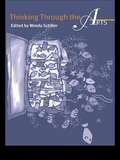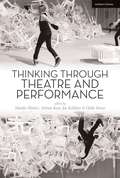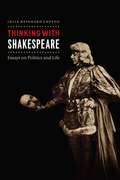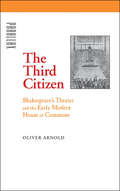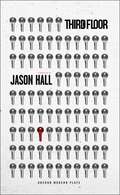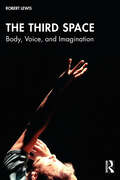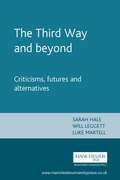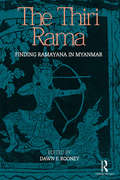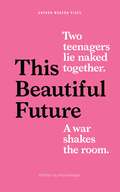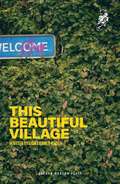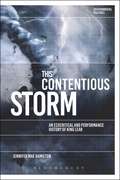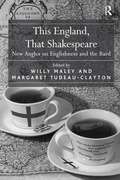- Table View
- List View
Thinking About Shakespeare
by Kay StockholderExplores the challenges of maintaining bonds, living up to ideals, and fulfilling desire in Shakespeare’s plays In Thinking About Shakespeare, Kay Stockholder reveals the rich inner lives of some of Shakespeare’s most enigmatic characters and the ways in which their emotions and actions shape and are shaped by the social and political world around them. In addressing all genres in the Shakespeare canon, the authors explore the possibility of people being constant to each other in many different kinds of relationships: those of lovers, kings and subjects, friends, and business partners. While some bonds are irrevocably broken, many are reaffirmed. In all cases, the authors offer insight into what drives Shakespeare’s characters to do what they do, what draws them together or pulls them apart, and the extent to which bonds can ever be eternal. Ultimately, the most durable bond may be between the playwright and the audience, whereby the playwright pleases and the audience approves. The book takes an in-depth look at a dozen of The Bard’s best-loved works, including: A Midsummer Night’s Dream; Romeo and Juliet; The Merchant of Venice; Richard II; Henry IV, Part I; Hamlet; Troilus and Cressida; Othello; Macbeth; King Lear; Antony and Cleopatra; and The Tempest. It also provides an epilogue titled: Prospero and Shakespeare. Written in a style accessible for all levels Discusses 12 plays, making it a comprehensive study of Shakespeare’s work Covers every genre of The Bard’s work, giving readers a full sense of Shakespeare’s art/thought over the course of his oeuvre Provides a solid overall sense of each play and the major characters/plot lines in them Providing new and sometimes unconventional and provocative ways to think about characters that have had a long critical heritage, Thinking About Shakespeare is an enlightening read that is perfect for scholars, and ideal for any level of student studying one of history’s greatest storytellers.
Thinking About Shakespeare
by Kay StockholderExplores the challenges of maintaining bonds, living up to ideals, and fulfilling desire in Shakespeare’s plays In Thinking About Shakespeare, Kay Stockholder reveals the rich inner lives of some of Shakespeare’s most enigmatic characters and the ways in which their emotions and actions shape and are shaped by the social and political world around them. In addressing all genres in the Shakespeare canon, the authors explore the possibility of people being constant to each other in many different kinds of relationships: those of lovers, kings and subjects, friends, and business partners. While some bonds are irrevocably broken, many are reaffirmed. In all cases, the authors offer insight into what drives Shakespeare’s characters to do what they do, what draws them together or pulls them apart, and the extent to which bonds can ever be eternal. Ultimately, the most durable bond may be between the playwright and the audience, whereby the playwright pleases and the audience approves. The book takes an in-depth look at a dozen of The Bard’s best-loved works, including: A Midsummer Night’s Dream; Romeo and Juliet; The Merchant of Venice; Richard II; Henry IV, Part I; Hamlet; Troilus and Cressida; Othello; Macbeth; King Lear; Antony and Cleopatra; and The Tempest. It also provides an epilogue titled: Prospero and Shakespeare. Written in a style accessible for all levels Discusses 12 plays, making it a comprehensive study of Shakespeare’s work Covers every genre of The Bard’s work, giving readers a full sense of Shakespeare’s art/thought over the course of his oeuvre Provides a solid overall sense of each play and the major characters/plot lines in them Providing new and sometimes unconventional and provocative ways to think about characters that have had a long critical heritage, Thinking About Shakespeare is an enlightening read that is perfect for scholars, and ideal for any level of student studying one of history’s greatest storytellers.
Thinking Through Place on the Early Modern English Stage (Early Modern Literary Geographies)
by Andrew BozioThinking Through Place on the Early Modern English Stage argues that environment and embodied thought continually shaped one another in the performance of early modern English drama. It demonstrates this, first, by establishing how characters think through their surroundings — not only how they orient themselves within unfamiliar or otherwise strange locations, but also how their environs function as the scaffolding for perception, memory, and other forms of embodied thought. It then contends that these moments of thinking through place theorise and thematise the work that playgoers undertook in reimagining the stage as the setting of the dramatic fiction. By tracing the relationship between these two registers of thought in such plays as The Malcontent, Dido Queen of Carthage, Tamburlaine, King Lear, The Knight of the Burning Pestle, and Bartholomew Fair, this book shows that drama makes visible the often invisible means by which embodied subjects acquire a sense of their surroundings. It also reveals how, in doing so, theatre altered the way that playgoers perceived, experienced, and imagined place in early modern England.
Thinking Through Place on the Early Modern English Stage (Early Modern Literary Geographies)
by Andrew BozioThinking Through Place on the Early Modern English Stage argues that environment and embodied thought continually shaped one another in the performance of early modern English drama. It demonstrates this, first, by establishing how characters think through their surroundings — not only how they orient themselves within unfamiliar or otherwise strange locations, but also how their environs function as the scaffolding for perception, memory, and other forms of embodied thought. It then contends that these moments of thinking through place theorise and thematise the work that playgoers undertook in reimagining the stage as the setting of the dramatic fiction. By tracing the relationship between these two registers of thought in such plays as The Malcontent, Dido Queen of Carthage, Tamburlaine, King Lear, The Knight of the Burning Pestle, and Bartholomew Fair, this book shows that drama makes visible the often invisible means by which embodied subjects acquire a sense of their surroundings. It also reveals how, in doing so, theatre altered the way that playgoers perceived, experienced, and imagined place in early modern England.
Thinking Through the Arts
by Wendy SchillerThinking Through the Arts draws together a number of different approaches to teaching young children that combine the experience of thinking with the act of expression through art. Developed as an inclusive, broad-ranging and user-friendly text, Thinking Through the Arts presents the unique insight of teachers as researchers, and counters the view that art is emotionally-based and therefore irrelevant to thinking and learning. The areas covered include drama, dance, music, arts environments, technologies, museums and galleries, literacy, cognition, international influences, curriculum development, research and practice. Early childhood and primary teachers and students alike will find this book is an invaluable source of new insights for their own teaching.
Thinking Through the Arts
by Wendy SchillerThinking Through the Arts draws together a number of different approaches to teaching young children that combine the experience of thinking with the act of expression through art. Developed as an inclusive, broad-ranging and user-friendly text, Thinking Through the Arts presents the unique insight of teachers as researchers, and counters the view that art is emotionally-based and therefore irrelevant to thinking and learning. The areas covered include drama, dance, music, arts environments, technologies, museums and galleries, literacy, cognition, international influences, curriculum development, research and practice. Early childhood and primary teachers and students alike will find this book is an invaluable source of new insights for their own teaching.
Thinking Through Theatre and Performance (Thinking through Theatre)
by Maaike Bleeker Adrian Kear Joe Kelleher Heike RomsThinking Through Theatre and Performance presents a bold and innovative approach to the study of theatre and performance. Instead of topics, genres, histories or theories, the book starts with the questions that theatre and performance are uniquely capable of asking: How does theatre function as a place for seeing and hearing? How do not only bodies and voices but also objects and media perform? How do memories, emotions and ideas continue to do their work when the performance is over? And how can theatre and performance intervene in social, political and environmental structures and frameworks? Written by leading international scholars, each chapter of this volume is built around a key performance example, and detailed discussions introduce the methodologies and theories that help us understand how these performances are practices of enquiry into the world. Thinking through Theatre and Performance is essential for those involved in making, enjoying, critiquing and studying theatre, and will appeal to anyone who is interested in the questions that theatre and performance ask of themselves and of us.
Thinking Through Theatre and Performance (Thinking through Theatre)
by Heike Roms Joe Kelleher Adrian Kear Maaike BleekerThinking Through Theatre and Performance presents a bold and innovative approach to the study of theatre and performance. Instead of topics, genres, histories or theories, the book starts with the questions that theatre and performance are uniquely capable of asking: How does theatre function as a place for seeing and hearing? How do not only bodies and voices but also objects and media perform? How do memories, emotions and ideas continue to do their work when the performance is over? And how can theatre and performance intervene in social, political and environmental structures and frameworks? Written by leading international scholars, each chapter of this volume is built around a key performance example, and detailed discussions introduce the methodologies and theories that help us understand how these performances are practices of enquiry into the world. Thinking through Theatre and Performance is essential for those involved in making, enjoying, critiquing and studying theatre, and will appeal to anyone who is interested in the questions that theatre and performance ask of themselves and of us.
Thinking with Shakespeare: Essays on Politics and Life
by Julia Reinhard LuptonWhat is a person? What company do people keep with animals, plants, and things? Such questions—bearing fundamentally on the shared meaning of politics and life—animate Shakespearean drama, yet their urgency has often been obscured. Julia Reinhard Lupton gently dislodges Shakespeare’s plays from their historical confines to pursue their universal implications. From Petruchio’s animals and Kate’s laundry to Hamlet’s friends and Caliban’s childhood, Lupton restages thinking in Shakespeare as an embodied act of consent, cure, and care. Thinking with Shakespeare encourages readers to ponder matters of shared concern with the playwright by their side. Taking her cue from Hannah Arendt, Lupton reads Shakespeare for fresh insights into everything from housekeeping and animal husbandry to biopower and political theology.
Thinking with Shakespeare: Essays on Politics and Life
by Julia Reinhard LuptonWhat is a person? What company do people keep with animals, plants, and things? Such questions—bearing fundamentally on the shared meaning of politics and life—animate Shakespearean drama, yet their urgency has often been obscured. Julia Reinhard Lupton gently dislodges Shakespeare’s plays from their historical confines to pursue their universal implications. From Petruchio’s animals and Kate’s laundry to Hamlet’s friends and Caliban’s childhood, Lupton restages thinking in Shakespeare as an embodied act of consent, cure, and care. Thinking with Shakespeare encourages readers to ponder matters of shared concern with the playwright by their side. Taking her cue from Hannah Arendt, Lupton reads Shakespeare for fresh insights into everything from housekeeping and animal husbandry to biopower and political theology.
Thinking with Shakespeare: Essays on Politics and Life
by Julia Reinhard LuptonWhat is a person? What company do people keep with animals, plants, and things? Such questions—bearing fundamentally on the shared meaning of politics and life—animate Shakespearean drama, yet their urgency has often been obscured. Julia Reinhard Lupton gently dislodges Shakespeare’s plays from their historical confines to pursue their universal implications. From Petruchio’s animals and Kate’s laundry to Hamlet’s friends and Caliban’s childhood, Lupton restages thinking in Shakespeare as an embodied act of consent, cure, and care. Thinking with Shakespeare encourages readers to ponder matters of shared concern with the playwright by their side. Taking her cue from Hannah Arendt, Lupton reads Shakespeare for fresh insights into everything from housekeeping and animal husbandry to biopower and political theology.
Thinking with Shakespeare: Essays on Politics and Life
by Julia Reinhard LuptonWhat is a person? What company do people keep with animals, plants, and things? Such questions—bearing fundamentally on the shared meaning of politics and life—animate Shakespearean drama, yet their urgency has often been obscured. Julia Reinhard Lupton gently dislodges Shakespeare’s plays from their historical confines to pursue their universal implications. From Petruchio’s animals and Kate’s laundry to Hamlet’s friends and Caliban’s childhood, Lupton restages thinking in Shakespeare as an embodied act of consent, cure, and care. Thinking with Shakespeare encourages readers to ponder matters of shared concern with the playwright by their side. Taking her cue from Hannah Arendt, Lupton reads Shakespeare for fresh insights into everything from housekeeping and animal husbandry to biopower and political theology.
Thinking with Shakespeare: Essays on Politics and Life
by Julia Reinhard LuptonWhat is a person? What company do people keep with animals, plants, and things? Such questions—bearing fundamentally on the shared meaning of politics and life—animate Shakespearean drama, yet their urgency has often been obscured. Julia Reinhard Lupton gently dislodges Shakespeare’s plays from their historical confines to pursue their universal implications. From Petruchio’s animals and Kate’s laundry to Hamlet’s friends and Caliban’s childhood, Lupton restages thinking in Shakespeare as an embodied act of consent, cure, and care. Thinking with Shakespeare encourages readers to ponder matters of shared concern with the playwright by their side. Taking her cue from Hannah Arendt, Lupton reads Shakespeare for fresh insights into everything from housekeeping and animal husbandry to biopower and political theology.
Thinking with Shakespeare: Essays on Politics and Life
by Julia Reinhard LuptonWhat is a person? What company do people keep with animals, plants, and things? Such questions—bearing fundamentally on the shared meaning of politics and life—animate Shakespearean drama, yet their urgency has often been obscured. Julia Reinhard Lupton gently dislodges Shakespeare’s plays from their historical confines to pursue their universal implications. From Petruchio’s animals and Kate’s laundry to Hamlet’s friends and Caliban’s childhood, Lupton restages thinking in Shakespeare as an embodied act of consent, cure, and care. Thinking with Shakespeare encourages readers to ponder matters of shared concern with the playwright by their side. Taking her cue from Hannah Arendt, Lupton reads Shakespeare for fresh insights into everything from housekeeping and animal husbandry to biopower and political theology.
The Third Citizen: Shakespeare's Theater and the Early Modern House of Commons (Parallax: Re-visions of Culture and Society)
by Oliver ArnoldThe new practices and theories of parliamentary representation that emerged during Elizabeth's and James' reigns shattered the unity of human agency, redefined the nature of power, transformed the image of the body politic, and unsettled constructs and concepts as fundamental as the relation between presence and absence. In The Third Citizen, Oliver Arnold argues that recovering the formation of political representation as an effective ideology should radically change our understanding of early modern political culture, Shakespeare's political art, and the way Anglo-American critics, for whom representative democracy is second nature, construe both. In magisterial readings of Titus Andronicus, Julius Caesar, Coriolanus, and the First Tetralogy, Arnold discovers a new Shakespeare who was neither a conservative apologist for monarchy nor a prescient, liberal champion of the House of Commons but instead a radical thinker and artist who demystified the ideology of political representation in the moment of its first flowering. Shakespeare believed that political representation produced (and required for its reproduction) a new kind of subject and a new kind of subjectivity, and he fashioned a new kind of tragedy to represent the loss of power, the fall from dignity, the false consciousness, and the grief peculiar to the experiences of representing and of being represented. Representationalism and its subject mark the beginning of political modernity; Shakespeare’s tragedies greet political representationalism with skepticism, bleakness, and despair.
Third Floor (Oberon Modern Plays)
by Jason Hall‘The last thing I want is all these total strangers, who live literally inches away from me, knowing every last detail of my life.'When a young woman buys her first flat it seems that all her dreams are coming true. Then she meets him. Overbearing, brash, and prone to spectacular gaffs, her across-the-hall neighbour is definitely strange – yet strangely attractive. But when an innocent prank goes horribly wrong the newly-formed friendship is pushed to breaking point. Only then do the neighbours realise they don't know as much about each other as they thought they did.A vertical thriller for a time when a stranger is only one wall away.
The Third Space: Body, Voice, and Imagination
by Robert LewisThe Third Space serves a crucial need for contemporary performers by providing an interdisciplinary and physiovocal approach to training. It is a new take on body and voice integration designed to develop the holistic performer. It takes performers through a series of step-by-step practical physiovocal exercises that connects the actor’s centre to the outside world, which increases awareness of self and space. It also develops a deeper connection between spaces within the body and the environment by connecting sound, imagination, and movement.Robert Lewis’s approach is a way of working that unlocks the imagination as well as connecting performers to self, space, and imagination, through voice and body. It conditions, controls, and engages performers by integrating various voice and movement practices.The theories and practice are balanced throughout by: introducing the practical works theoretical underpinnings through research, related work, and case studies of performances; demonstrating a full program of exercises that helps performers get in touch with their centre, their space, and shape both within and outside the body; and exploring the performers physiovocal instrument and its connection with imagination, energies, and dynamics. This book is the result of nearly 20 years of research and practice working with voice and movement practitioners across the globe to develop training that produces performers that are physiovocally ready to work in theatre, screen, and emergent technologies.
The Third Space: Body, Voice, and Imagination
by Robert LewisThe Third Space serves a crucial need for contemporary performers by providing an interdisciplinary and physiovocal approach to training. It is a new take on body and voice integration designed to develop the holistic performer. It takes performers through a series of step-by-step practical physiovocal exercises that connects the actor’s centre to the outside world, which increases awareness of self and space. It also develops a deeper connection between spaces within the body and the environment by connecting sound, imagination, and movement.Robert Lewis’s approach is a way of working that unlocks the imagination as well as connecting performers to self, space, and imagination, through voice and body. It conditions, controls, and engages performers by integrating various voice and movement practices.The theories and practice are balanced throughout by: introducing the practical works theoretical underpinnings through research, related work, and case studies of performances; demonstrating a full program of exercises that helps performers get in touch with their centre, their space, and shape both within and outside the body; and exploring the performers physiovocal instrument and its connection with imagination, energies, and dynamics. This book is the result of nearly 20 years of research and practice working with voice and movement practitioners across the globe to develop training that produces performers that are physiovocally ready to work in theatre, screen, and emergent technologies.
The Third Way and beyond: Criticisms, futures and alternatives
by Sarah Hale Luke Martell Will LegettThis collections brings together expert contributions to dissect the key political concept of the Third Way in theory and practice, assessing its development and legacy and suggesting criticisms and alternatives.
The Thiri Rama: Finding Ramayana in Myanmar
by Dawn F. RooneyThe Thiri Rama – or the Great Rama – was written for court performance and is the only known illustrated version of the Ramayana story in Myanmar. Based on palm-leaf manuscripts and scenes carved on over 300 sandstone plaques at a mid-nineteenth-century Buddhist pagoda west of Mandalay in Myanmar, this book presents an original translation of the Thiri Rama rendered in prose. The volume also includes essays on the history and tradition of the Ramayana in Myanmar as well as the cultural context in which the play was performed. It contains many helpful resources, incorporating a glossary and a list of characters and their corresponding personae in Valmiki’s Ramayana. With over 250 fascinating visuals and core text contributions by distinguished Burmese scholars, U Thaw Kaung, Tin Maung Kyi, and U Aung Thwin, this book will greatly interest scholars and researchers of South and Southeast Asian culture, literary forms, epics, art and art history, theatre and performance studies, religion, especially those concerned with Hinduism, as well as folklorists.
The Thiri Rama: Finding Ramayana in Myanmar
by Dawn F. RooneyThe Thiri Rama – or the Great Rama – was written for court performance and is the only known illustrated version of the Ramayana story in Myanmar. Based on palm-leaf manuscripts and scenes carved on over 300 sandstone plaques at a mid-nineteenth-century Buddhist pagoda west of Mandalay in Myanmar, this book presents an original translation of the Thiri Rama rendered in prose. The volume also includes essays on the history and tradition of the Ramayana in Myanmar as well as the cultural context in which the play was performed. It contains many helpful resources, incorporating a glossary and a list of characters and their corresponding personae in Valmiki’s Ramayana. With over 250 fascinating visuals and core text contributions by distinguished Burmese scholars, U Thaw Kaung, Tin Maung Kyi, and U Aung Thwin, this book will greatly interest scholars and researchers of South and Southeast Asian culture, literary forms, epics, art and art history, theatre and performance studies, religion, especially those concerned with Hinduism, as well as folklorists.
This Beautiful Future (Oberon Modern Plays)
by Rita KalnejaisElodie is 17. She’s French. She lets down her hair and puts it up again. She finds reflective surfaces everywhere. She tests new looks. Otto is 15. He’s a German soldier. He brushes his hair to make the shape of his head more perfectly oval. He tries not to look at himself in the mirror. It’s 1944. Elodie and Otto are experiencing love for the very first time. Outside, the world around them is exploding. Inside, the room shakes. Elodie and Otto’s bodies touch. Fusing youth with old age, the past with the present, pop tunes with Stalingrad, This Beautiful Future is about love in the extreme.
This Beautiful Village (Oberon Modern Plays)
by Lisa Tierney-KeoghOn a quiet suburban street in Dublin, a piece of graffiti tears apart a group of neighbours, exposing a deep divide between them. In one long scene over one night, six people must confront their pride, privilege and prejudice. Who will concede power and how will they move forward? This Beautiful Village is a play about power. It breaks open the wounds of hurt women to reveal a story as relevant in Ireland as anywhere. It is an urgent message that exposes every side of the complex and ugly reckoning we are all facing. Power will be undone. It won’t be pretty. But it could be beautiful.
This Contentious Storm: An Ecocritical and Performance History of King Lear (Environmental Cultures)
by Jennifer Mae HamiltonFrom providential apocalypticism to climate change, this ground-breaking ecocritical study traces the performance history of the storm scene in King Lear to explore our shifting, fraught and deeply ideological relationship with stormy weather across time. This Contentious Storm offers a new ecocritical reading of Shakespeare's classic play, illustrating how the storm has been read as a sign of the providential, cosmological, meteorological, psychological, neurological, emotional, political, sublime, maternal, feminine, heroic and chaotic at different points in history. The big ecocritical history charted here reveals the unstable significance of the weather and mobilises details of the play's dramatic narrative to figure the weather as a force within self, society and planet.
This England, That Shakespeare: New Angles On Englishness And The Bard (PDF)
by Willy Maley Margaret Tudeau-ClaytonIs Shakespeare English, British, neither or both? Addressing from various angles the relation of the figure of the national poet/dramatist to constructions of England and Englishness this collection of essays probes the complex issues raised by this question, first through explorations of his plays, principally though not exclusively the histories (Part One), then through discussion of a range of subsequent appropriations and reorientations of Shakespeare and 'his' England (Part Two). If Shakespeare has been taken to stand for Britain as well as England, as if the two were interchangeable, this double identity has come under increasing strain with the break-up - or shake-up - of Britain through devolution and the end of Empire. Essays in Part One examine how the fissure between English and British identities is probed in Shakespeare's own work, which straddles a vital juncture when an England newly independent from Rome was negotiating its place as part of an emerging British state and empire. Essays in Part Two then explore the vexed relations of 'Shakespeare' to constructions of authorial identity as well as national, class, gender and ethnic identities. At this crucial historical moment, between the restless interrogations of the tercentenary celebrations of the Union of Scotland and England in 2007 and the quatercentenary celebrations of the death of the bard in 2016, amid an increasing clamour for a separate English parliament, when the end of Britain is being foretold and when flags and feelings are running high, this collection has a topicality that makes it of interest not only to students and scholars of Shakespeare studies and Renaissance literature, but to readers inside and outside the academy interested in the drama of national identities in a time of transition.
